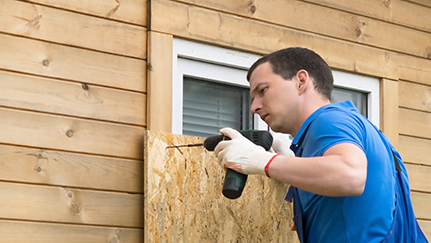Stormy weather? Prioritize protecting your home

It's not your imagination. Weather has become more volatile in recent years, and the frequency and severity of convective storms has been on the rise. This includes powerful thunderstorms, tornados, heavy winds and hail-all weather phenomena that can cause significant damage to homes and other structures.
These storms come with a hefty price tag. In 2022, just 11 severe convective storm events resulted in more than $1 billion in losses, according to the 2023 Severe Convective Storm Risk Report by CoreLogic.1
There's no end in sight to the increasingly destructive weather changes.
"The last few years have been marked by some of the most devastating storms in recorded history," explains Crissy Seals, Director of Regional Partners at E&S Wholesale in Contract Personal Lines. "To exacerbate the situation, we are witnessing an alarming escalation in severe weather events, a trend that has been intensifying since 2020. This year alone, we are expecting an above-normal hurricane season with up to 25 named storms and 13 major hurricanes."2
The domino effect
Storm activity has been shifting into areas where it hasn't been seen historically. One example is more tornados outside Tornado Alley, the area in the central U.S. where most tornados have historically occurred. At the same time, people are building more houses in remote areas and along coastlines, locations that are seeing increased weather-related events.
"In previous years, severe weather events often occurred in regions devoid of residential development. However, as the housing market expands to accommodate growing consumer demand, homeowners are increasingly constructing residences in rural and remote areas," observes Crissy Seals, Director of Regional Partners at E&S Wholesale in Contract Personal Lines. "This expansion has coincided with escalating climate volatility, resulting in a heightened frequency of interactions between humans and severe weather phenomena. Recent studies indicate that the number of U.S. housing units at risk of flooding has tripled over the past two decades,3 underscoring the urgent need for strategic planning and resilient infrastructure."
The result is more extensive damage to more properties.
"This has created greater demand to repair homes, which leads to higher repair costs and extended recovery time," she adds.
The ripple effect doesn't end there. Displaced homeowners are looking for rentals while their homes are being repaired at a time when rental properties are scarce in many areas and rents are on the rise.
Insurers are also feeling the pressure. Some are experiencing heavy or record losses, while others are exiting high-risk markets. This leaves insureds with rising premiums and fewer options for coverage in some areas.
An ounce of prevention
Fortunately, there are steps homeowners can take to make their homes more resilient in the aftermath of a convective storm. A good place to start is one of the first lines of defense from the elements: the roof.
"It's a good idea to invest in wind- and hail-resistant roof types if you live in an area with frequent storms," notes Seals.
There are ways to make a standard roof more resilient, too. Seals recommends homeowners perform regular maintenance on their roof to ensure it is structurally sound and that there are no leaks. It's also a good idea to properly seal the area around any chimneys or vent pipes to prevent water from entering the home during a storm. In addition, keep gutters and downspouts free of debris that may block water from flowing away from the home's foundation.
Of course, sometimes a roof has outlived its useful life. When that happens, it's important to work with a roofing professional to replace it with a new one that is designed to withstand any severe weather that may occur in the area.
It's also a good idea to check doors and windows to make sure they are sealed tight so water and wind can't get through and cause property damage. Storm shutters and steel doors offer another layer of protection to homes in areas that see storms accompanied by damaging high winds, and so does securely bolting the home's foundation into place.
Safeguarding what matters with the right coverage
On top of these physical measures, having the right insurance is essential to protecting homeowners in storm-prone locations.
"Partner with an insurance agent to get a clear understanding of the risks in your area and to ensure you have the right coverage," advises Crissy Seals. "An agent can help navigate complexities and find the best protection for homeowners."
Nationwide is committed to partnering with its wholesale agents to ensure they understand the unique weather patterns and risks within their territories. Armed with this knowledge, they can provide the best guidance possible to insureds so they can feel secure in the fact that they have a safety net in the event that powerful weather damages their home and belongings.
"With insurance, you're buying protection and the ability to get your life back to what it was before the storm," Seals says. "We are here to provide that protection and peace of mind."